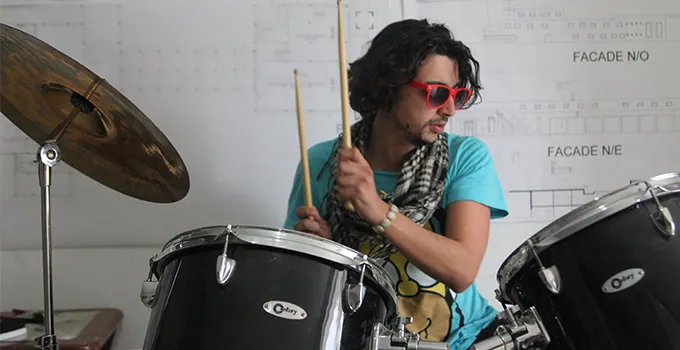
We may earn a commission from the affiliate links on this site. Learn more›
Approaching a drum kit can be overwhelming when you’ve never played before. There are so many questions. Which drum do you hit first? Which cymbal is the loudest? What’s the right way to hold my sticks? The good thing is playing the drums doesn’t have to be as tricky as it looks.
With the right tools, guidance, and a lot of practice, sitting at a set of drums won’t feel intimidating. There are 40 American drum rudiments in all but listed below are seven beginner rudiments that will send you on your way to becoming a professional.
What are Drum Rudiments?
Drum rudiments are sticking patterns you can play on one drum, percussion instrument, or drum set. They are a set foundation that can be creatively turned into more complex patterns. In particular, beginners typically start with seven rudiments: single stroke roll, double stroke roll, single paradiddle, flam, double paradiddle, drag, and multiple bounce/buzz roll.
The great thing about learning these is that you don’t have to have a whole drum set to understand them. You can practice on anything from a practice pad to your pillow. If you’re not at home, you can use your knee!
These seven, when mastered, will guide you to creating drum beats and fills on your drum set.

Single Stroke Roll
You can’t play many rudiments without first learning the single-stroke roll. Both beginners and pros use this rudiment in any song, regardless of tempo. That’s why it is the first technique to learn and sharpen.

The steps are simple. It consists of you playing consistent alternate strokes. Each hand plays one note. Your sticks should go right left right left, or left right left right (RLRL or LRLR).
To practice on beat, you need a metronome to set a time. Setting a slow, comfortable pace to start is perfectly fine. Once you get used to playing the single-stroke roll to the metronome, try alternating which hand you begin with.
As you learn to read music and even learn more advanced rudiments, it’s going to be essential to know how to begin on alternate hands.
Double Stroke Roll

Once you feel comfortable and confident in playing the most essential rudiment, the single-stroke roll, you can move on to the next rudiment. Naturally, it would be a double-stroke roll.
Learning this rudiment next is necessary but just as simple as a single-stroke roll. The double-stroke roll consists of the same concept as the single-stroke roll, only it is made up of two strokes per beat with one hand instead of one.
Your sticks should go right right left left, or left left right right. (RRLL or LLRR). When you speed up the pace of this rudiment, it soon becomes a roll. Once you gain confident control of this rudiment, you can move to the drum kit and incorporate the kick drum or cymbal. Mastering this rudiment is the key to leveling up to more advanced rudiments.
Single Paradiddle
After you have mastered or gained pretty good confidence in the single and double-stroke roll, the next rudiment to move to is the single paradiddle.
Paradiddle sounds strange, right? But it means exactly what it is. “Para” means single stroke, and “diddle” means double stroke. So, therefore, a single paradiddle combines the single-stroke roll and double-stroke roll.
With your sticks, you would go left right left left or right left right right (LRLL or RL RR). It is a fun rudiment to practice because it tests your coordination. Once mastered, it is also perfect for moving each stroke around the drum kit.
However, as a beginner, it’s better to learn it on a practice pad. For this challenging rudiment, it’s recommended to start at a slower pace with your metronome and work your way up.
Flam
The flam is an exciting rudiment for beginners to learn. The written note may seem simple, but it requires precise technique. At first glance, it looks like a single stroke, but a smaller note is attached. That note is called a grace note.
When it comes to playing on the beat, the grace note only consists of a small part of the beat. This note is played slightly before and light enough to be heard.
The single stroke you would see next to it would takes up the rest of the beat. Figuring out how to place your sticks helps to execute this rudiment.
For instance, to play the grace note, you barely have to lift your stick when you strike the practice pad and hit the pad regularly for the single stroke. For a beginner, this note is challenging because you can’t hit the grace note so lightly that you don’t hear it or too long, where you don’t have time for the single stroke.
You can’t hit the grace not too loud or too long that it starts to sound like a double-stroke roll when paired with the single stroke. It’s an intricate yet straightforward rudiment that will be simple once you get the technique.
The grace note of a flam can also be played louder or at the same volume as the primary stroke in specific contexts, so be aware.
Five Stroke Roll
The next rudiment to learn is a five-stroke roll. This rudiment is similar to the single and double-stroke roll, but now that you have mastered those, extra strokes can be added.
The five-stroke roll combines two single and two double-stroke rolls with an accented single stroke. That would be right right left left right, or left left right right left (RRLLR or LLRRL).
Always practice these rudiments with alternate hands so that once you move to a drum kit, you can easily alternate the strokes between the different drums. Just like with the other rudiments mentioned above, it’s best to start practicing the five-stroke roll with the metronome as slowly as possible, only increasing your speed when you have mastered it.
Drag
The drag is another interesting rudiment where it looks like one note at first glance but has a little more to pay attention to.
Much like the flam, it consists of grace notes on top of a single stroke. The difference between a drag and a flam is that a flam has one grace note, while a drag has two grace notes followed by a single stroke.
Just like the flam, the grace notes of the drag should be played just enough to hear. Two quick taps, lifting the stick up just enough, and then a regular single stroke. The grace notes of the drag should never be louder than the first stroke. Like the flam, the drag will be a simpler rudiment to practice once you get familiar with the technique.
Multiple Bounce/Buzz Roll
The 7th rudiment for beginners to learn is the multiple-bounce roll. If you are a beginner interested in playing in a marching band or an orchestra, this is a rudiment that is often used. Other drummers use them creatively on the drum set with drum fills.
The multiple bounce roll consists of several bounced single strokes back-to-back. Work up to a speed where your strokes form a smooth roll. Because the strokes are meant to create a buzz, there isn’t a specific number of strokes assigned to this rudiment.
To create the buzz sound, the idea is to push your stick into your drum head when you play each stroke. To practice this rudiment, start at a slow speed and with the help of your metronome. Once you are comfortable with one speed, move up to another, and you will create buzz rolls in no time.
How Long Should You Practice
The decision of how long you should practice solely depends on the drummer and how often you practice. The idea is to practice each of these rudiments slowly until you can play them at the quickest speed possible.
You can record yourself to see where you need to improve and keep track of how fast you can play. There are several ways that you can get creative with your practice and make sure that you practice consistently.
Most players still practice these rudiments as a warmup no matter how advanced they are, so take the idea of practice as something you will be doing for as long as you continue to learn and play the drums.
Conclusion
These seven rudiments are explicitly chosen for beginners because they are the first variations of the other 40 rudiments. As you perfect the basics and evolve, you will also learn that the difficulty levels of these rudiments develop.
Some like a single dragadiddle, or a flamacue, morph into each other as you become more advanced. Mastering the basics helps advance you, strengthens your chops and provides a solid foundation to learn. It’s not going to be easy but once you get them you can challenge yourself with speed which is always fun.



